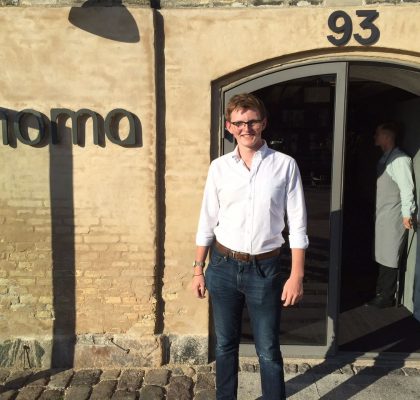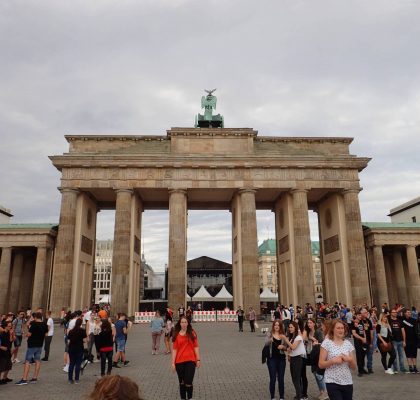Istanbul is an easy city to be lazy in. It seemed like every day I would end up in a café for several hours, just sipping on tea and coffee with some people from the hostel. After all, it’s impossible to ‘understand’ Istanbul, a city of 12, 18, or 20 million depending on who you ask, in just a few days. So, instead I think it’s better to be content exploring however much you feel like. You could live here half your life and still find new pockets, new nooks and crannies to explore. It can be overwhelming for the newcomer, and tempting just to follow the guidebooks and run the tourist attraction gauntlet.
My advice for getting the most out of Istanbul? Find Turkish friends. Whether it’s through Couchsurfing, mutual friends, striking up conversations, or even Tinder, Istanbul is one of those cities that becomes much better with a friend.
An anecdote: whenever I would wander Istanbul alone, I would most often than not find myself surrounded by bleak apartments, sullen children, fasting Muslims, and expressways. I’m usually pretty good at cities, but Istanbul is particularly sprawling and maze-like. Whenever I met with my friend, however, these were replaced with beautiful old buildings, cobbled streets and lively markets, plump, purring stray cats. Oh yeah, and amazing food: an incomprehensible stream of Turkish – did I hear ‘dürüm’, or was that just an adjective? – resulting in an array of Turkish classics: grilled meats and vegetables, fried fish with fresh bread, sheep’s cheese.
Speaking of Turkish food, their breakfasts are famously excellent…

And a ‘real’ Turkish breakfast eaten streetside in a trendy café:


Bal kaymak deserves special mention as a crown jewel of Turkish breakfast – it’s clotted cream sitting in a pool of honey, unctuous and creamy, waiting to be mopped up by the fresh bread which always accompanies meals in Turkey.
During my time in Istanbul, I was often struck by how common riot police and heavily armed guards had become. I know it’s reasonable to expect increased security after all the unrest/terror, but I never got used to seeing entire squads of black-body-armoured, submachine-gun-wielding riot police. These guys were almost always accompanied by a crowd-control-outfitted vehicle, some armour-plated monstrosity mounted with a water cannon. Especially on the main shopping street, Istiklal, you couldn’t walk more than a hundred metres without seeing some. The one time in Istanbul – and indeed my whole trip so far – I felt a little unnerved, eager to leave was a particular Sunday. The Turkish LGBT community had planned a pride parade, but ISIS had threatened to bomb it, and so the Turkish government had prohibited the parade from taking place – at least, that was the official story. Many felt that it was just an excuse for the government to suppress LGBT people, and so turned up anyway. Walking down Istiklal that morning there was half an army of uniformed police, many holding tear gas canisters and batons, and all heavily armoured. When I came back down the street later the day, I wondered why everyone was walking in the opposite direction, some coughing, the air looking a little hazy – until I smelt it. They don’t lie when they call it ‘tear gas’, it’s like you suddenly can’t stop coughing, your eyes start watering.
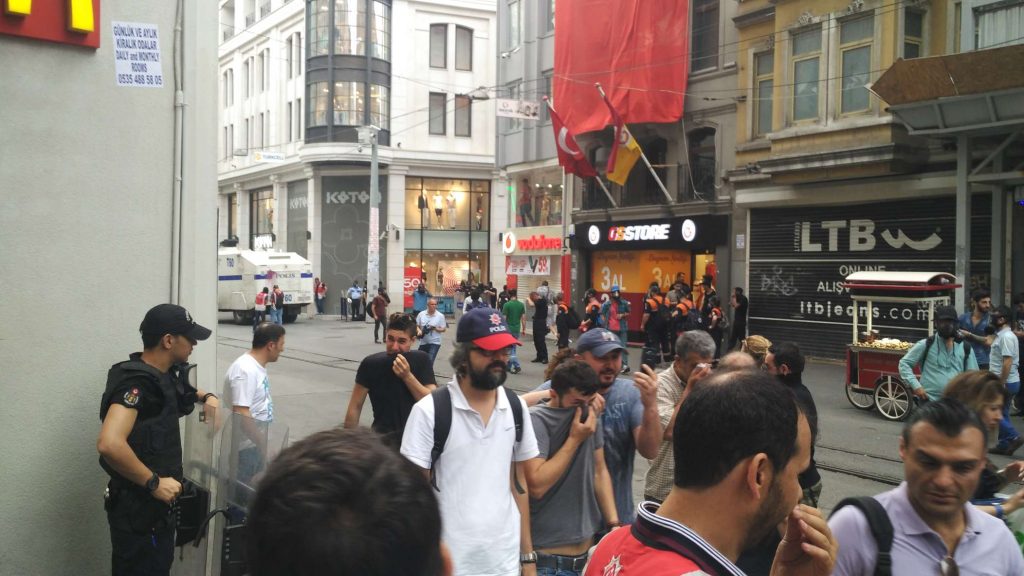
At the same time as all of this unrest was happening, life must go on in Turkey. There is still food being served, goods being sold, jobs to be done.

In Moda district, on the Asian side of the Bosphorus, there is one particular ice creamery which consistently packed – and for good reason. The original branch, imitated throughout Turkey, has exceptional ice cream. Interestingly, it’s not ‘Turkish’ ice cream, which is itself a chewier, stretchier specialty from Kahramanmaras, but nor is it traditional straight cream-based Western ice cream – more something in between the two.
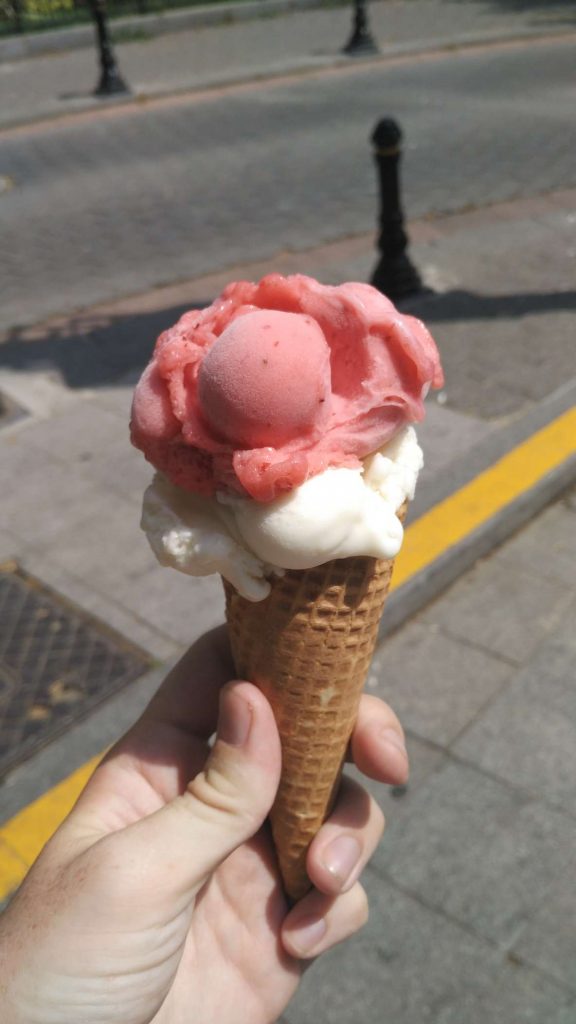
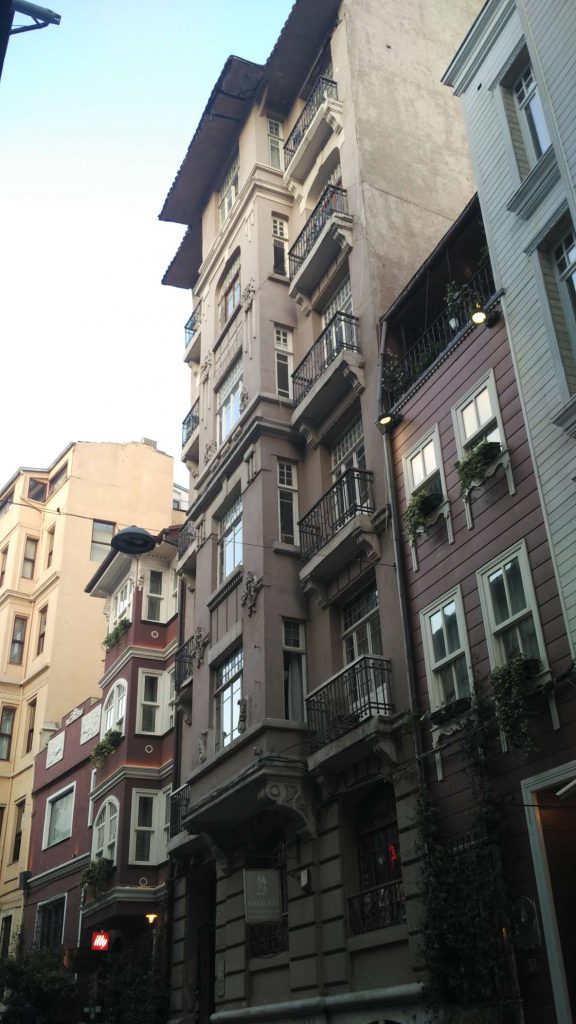
Çay, or tea, is a massive part of daily life in Istanbul – and most of Turkey, for that matter. Every few metres there’s another place to get your fix, most of them populated at all hours – the tea shops in Istanbul’s conservative areas being the notable exception. I have been told more than once that if Erdoğan were to ban çay cigara, tea and cigarette, he would have a nationwide revolt on his hands.
Çay is most often served in a delicate glass with a thick bottom which curves inwards and then flares out again at the top. It looks something like the head of a mallet. Into this cup goes first a concentrated tea mixture which leaves a few leaves swirling in the glass, then this is topped up with boiling water. Drink to your liking, adding one, two, or more sugar cubes. Milk in Turkish tea is frowned upon and laughed at. One night I remember lying in bed, wide awake at 11:30pm. “Why can’t I sleep?”, I thought – “Oh, right. I had six teas today.” Such is life in Istanbul – all things naturally converge to tea. Well, and kebabs.
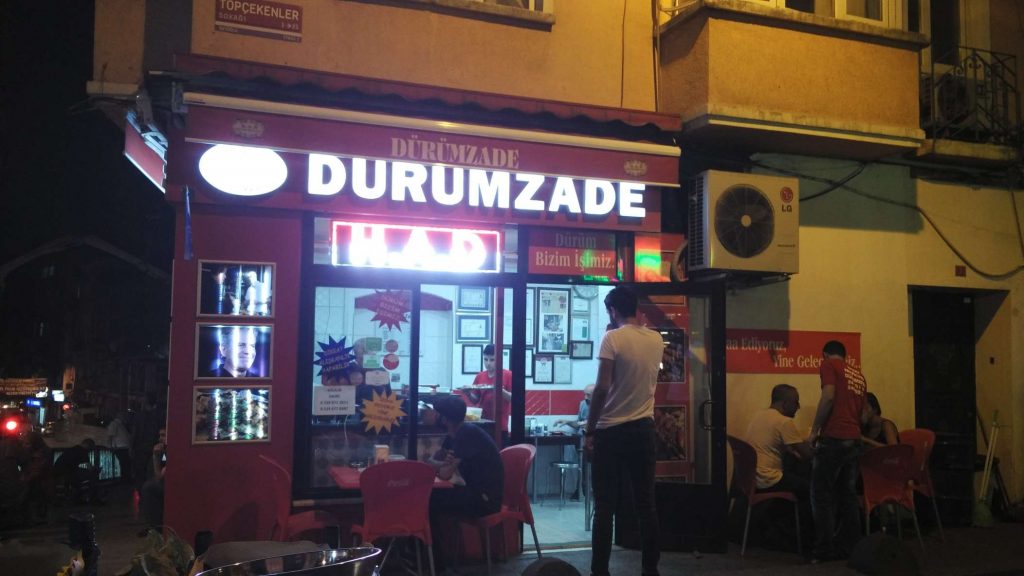
Despite all stereotypes, kebab in Turkey is stunningly good; enough to make you think in horror ‘what have I been eating back home?!’ Best eaten after a) excessive quantities of alcohol or b) to fend off the next morning’s hangover, this particular place elevates the Adana kebab to its highest possible point while still being able to be eaten streetside.

Believe it or not, one of the best things about this particular place – famous throughout the city – is the bread. The cook doesn’t let any of the fat from the cooking fall onto the coals, therefore preventing flare-ups, but instead mops it up with the bread and toasts it to crispy, greasy perfection.



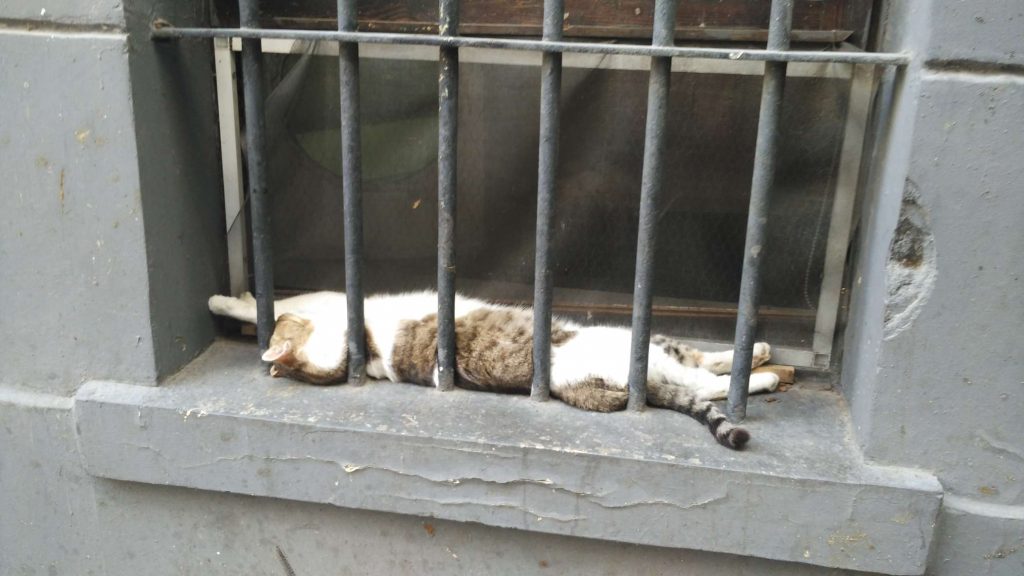
It’s a strange contrast, being in a city with so much to explore, so much food to try, and good memories to make, and being there during something terrible like the Ataturk airport bomb. I remember I had just headed out to a local pub with another hostel guest and the three hostel owners. I went to get a few beers, came back and said with a grin “who’s ready for a beer?!” – but everyone was glued to their phones. “A bomb’s just gone off at the airport.” Oh. That put a rather forceful downer on the evening – rightfully so, I guess. Things were just looking up for Turkish tourism (which was down 30% on last year): the government had six days earlier apologised to Russia and it looked like Russian tourism would return, but now ISIS attacks the international arrivals terminal – a clear message to tourists. We spent the rest of the night in relatively sullen silence, grimly watching the body count rise. An uncommon way to spend an evening in Istanbul, but perhaps still too common – my Turkish friends’ biggest concern was how normalised this was becoming for them. Something like 500 Turks had been killed by terror attacks in the past year. Unhappy stuff… countered best by good food and friends.
One of the more modest, working-man’s dishes is pilav – rice cooked with butter and occasionally light spices, which is then served with chicken or beef or stewed beans. With a guy from the hostel, I checked out Istanbul’s oldest pilav restaurant: Tarihi Kalkanoğlu Pilavcısı (the ‘i’ without a dot is pronounced ‘uh’). They’ve been serving pilav for five generations, since 1856, and now have several branches throughout Turkey. Especially impressive, considering they serve three things and three things only: pilav rice, stewed beans, and slow-cooked beef. It doesn’t look like much, but it was far and away one of the stand-out meals in Istanbul. You honestly wonder how rice could ever taste that good! Cheap-ish, too, at $7 AUD for a meal that’ll last you most of the day.
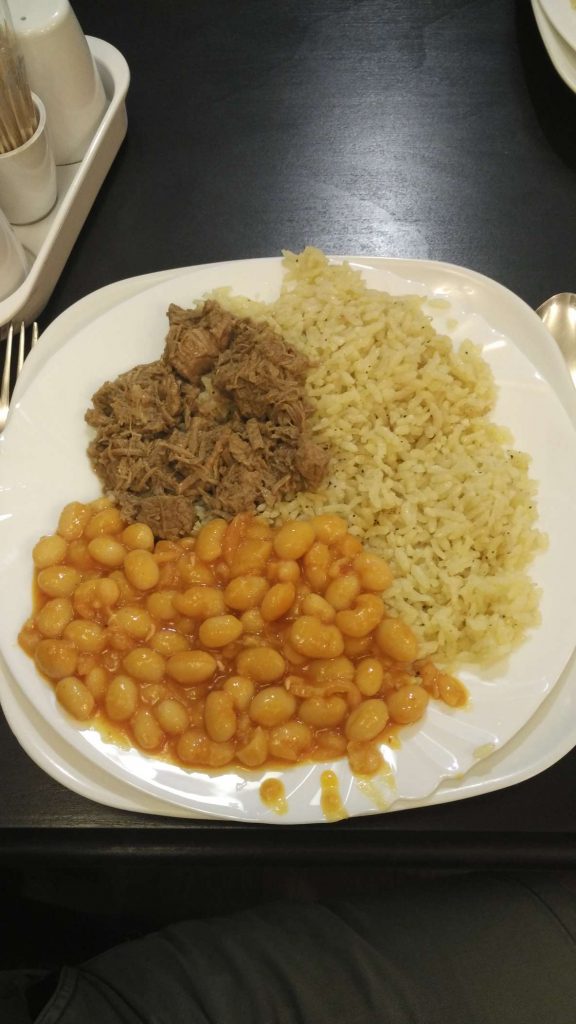

Ferries in Istanbul are something of a public transport institution – for about 3 lira you get a sea breeze, the smell of the Bosphorus, gulls circling overhead, and the sea-horns of ships. Sitting in the shade on the side of a ferry looking out over the Istanbul cityscape, it’s easy to get lost in thought, in naval romanticism: I saw a container ship leaving port, VENEZIA printed in white on its stern, bound for Venice, and was briefly inspired to try and hitch a ride on one. Some frantic googling unfortunately revealed that regulations and liabilities are far too high, and I’d rather not risk stowing. Despite imaginings, a ride on a ferry – at least twice a day – should be on every Istanbul visitor’s list.

As the sun nears the horizon during Ramadan, all over Istanbul wood ovens are being prepared, dough is being leavened, teas are being drunk (only by the chefs who choose not to observe Ramadan, of course), all in preparation for the iftar rush. Turkey being the civilized country that it is, people expect fresh bread in the morning and the night, a requirement magnified by the type of bread demanded – when you bake large, softer loaves as in the West you can get away with one session in the early morning, but if you need to produce thin, crispy-yet-soft lavash or pide, you must bake at least twice a day. Some even fire up for lunchtime, or keep a fire running nonstop. This particular place was somewhere around Kadikoy, and was clearly a neighbourhood favourite as the bakers were working nonstop: a fantastically rhythmic pat-pat-pat as they stretched out the dough and sprinkled it with mince, chopped vegetables, herbs, and cheese. Instead of spinning the dough, a la Guido pizzeria, or rolling it, the baker would first smash the dough portion on the counter, then use the thumb end of his palms as a fulcrum to push apart the dough with the pinky end of his palms. Then he’d rotate and repeat until he had a roughly 12 inch diameter disc maybe 1cm thick.

Lahmahcun should only really be eaten when fresh out of the wood oven – the same way a Napoli pizza should be eaten – in those magic few minutes when it’s crispy, yet soft. You’re given a plate of shredded lettuce and chopped tomatoes and cucumber which you can stuff inside to your liking before eating it like a New York pizza – folding up and cramming into pie-hole. Would highly recommend.
I ‘finally’ left Istanbul after a week, with new shoes (the closest I could find to my old pair – I ended up getting the last pair in Turkey in the colour I wanted), a new Swiss Army Knife, and a lot of great memories, a few new friends, and most importantly, plenty of sampled food. I’ll end this post now, heading towards the overnight train to Bulgaria with a new Dutch friend.
It’s a shame that the Turkish government is what it is: for all of its problems, Turkey is a wonderful place. It’s so far been the standout in terms of hospitality, food, and friendliness – not to mention natural beauty. I will without a doubt return – if only to eat the food once more!
‘Til next time,
– Alex
